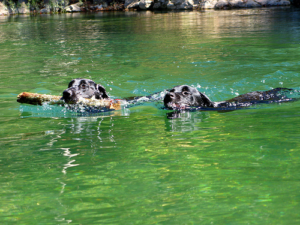
In the summer months, Labrador retrievers love to go swimming, whether in a pool, lake or other body of water. These dogs are excellent swimmers. In fact, it can be one of the things that encourages dog owners to choose this breed. However, what happens when your dog experiences a problem after he has gone for a swim. Understanding what swimmer’s tail is and how it is treated can help make things easier for your dog if the problem occurs.
Symptoms
Swimmer’s tail doesn’t often appear until the following day so it is important to know what is going on if your dog wakes up in pain, unable to wag his tail. Some of the most common symptoms of this condition in your dog includes:
- Excessive panting
- Bloodshot eyes
- Inability to get comfortable
- Biting at the base of the tail
- Obvious pain, especially if you touch his tail
Causes
Swimmer’s tail, also known as limp tail and cold tail, is often caused by swimming in water that is too cold. When your Labrador swims in the cold water, he can overwork his muscles in his tail and develop something similar to cramps. When he leaves the cold water into the hot air of the summer, this can cause the condition to worsen. However, the symptoms don’t often show up immediately, which can leave you wondering what is wrong if you aren’t familiar with the condition.
Treatment
If you notice that your dog is showing symptoms of this condition, it is best to visit the veterinarian as soon as possible. This is because the condition often requires the use of anti-inflammatory drugs that will help your pet to heal. Keeping him out of the water while he heals will also help. However, if it isn’t bothering your dog much, you can avoid the medications and the condition will resolve itself. The medications will make your Labrador more comfortable, though.
It can be difficult to see your Labrador in pain, but you can’t avoid every problem. If you suspect your dog has developed swimmer’s tail, a trip to the veterinarian can provide you with diagnosis you need and medication if your pet needs it. While you can’t always prevent this condition, making sure your dog only swims in warmer bodies of water. This can reduce the risk of developing the condition.












